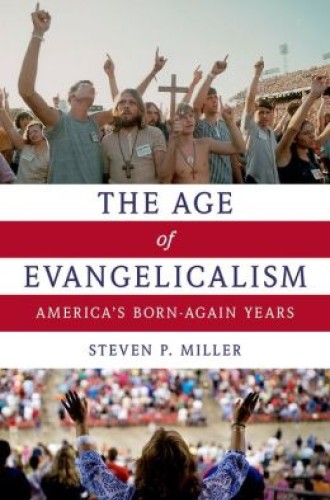The Age of Evangelicalism, by Steven P. Miller
The musical Hair may have been great comedy when it was released in 1967, but it was poor prophecy. The spirit of the 1960s had audiences singing that it was the “dawning of the Age of Aquarius.” Nine years later, Time magazine declared that 1976 was the “year of the evangelical.” Seven years after that, President Reagan was calling for 1983 to be the “year of the Bible.”
Then in the new millennium, pundits began discussing a God gap between the political parties. How did the era of the new left and the hippie harems give way to the age of the new right and evangelical empires? In this short and brisk book, historian Steven P. Miller maintains that evangelicalism marked an era because it was enmeshed in how Americans conceived of the links between religion, politics, and the public.
Read our latest issue or browse back issues.
The watershed moment was Watergate. It left a vacuum of moral leadership and propelled the search for something new. Almost like magic, a new type of identity emerged—the born-again person. Unlike the biblical Nicodemus, many Americans of the 1970s were anything but perplexed when they learned that they must be, as Jesus explained, born again. These individuals could be found all over the American map. The most obvious was Jimmy Carter, whose born-again label helped launch him toward the White House. There were also singer-songwriter Bob Dylan, misogynist essayist Eldridge Cleaver, and Nixon tough guy Chuck Colson.
In the 1970s, evangelicalism had not yet become tethered to conservative politics. Carter, a Democrat, received almost 50 percent of the evangelical vote (Nixon had received 84 percent in 1972). The evangelical left of Ron Sider and Jim Wallis took shape in the 1970s too. In that decade evangelicalism seemed noteworthy less for being conservative than for being cool.
Then came Ronald Reagan. If 1976 was the year of the evangelical, then 1980 was the year of the evangelical right. Televangelists Jerry Falwell and Pat Robertson puffed Reagan. They were thrilled when Reagan declared 1983 the year of the Bible, and they reveled in his 1984 book In God I Trust. Evangelicals rallied to the work of Francis Schaeffer and his attacks on secular humanism. The 1990s, though, were a tough time for conservative evangelicals. They lost the presidency to Bill Clinton and then failed to defeat him even after yet another sex scandal. If Reagan was the “Teflon president” on whom nothing could stick, Clinton was the comeback kid.
Then came George W. Bush. As Miller points out, Reagan was the evangelicals’ president, but Bush was the evangelical president. He became the “de facto head of evangelicalism,” and “faith-based initiatives” became popular. Bible study was not mandatory in the White House, but it was not exactly optional either. Following the 9/11 terrorist attacks, international relations were discussed in terms of good and evil. Americans flooded movie theaters to watch The Passion of the Christ, in which Jesus was whipped so many times they were reduced to tears. “What would Jesus do?” became a fashion statement, and Christian musicians made big bucks. All of this left Democrats scrambling to bridge the God gap. Then Barack Obama strode in, a young politician who seemed to be able to address both secularists and evangelicals (or at least the evangelical left).
Most of the above is common knowledge for those who pay attention. What is novel about Miller’s book is the way he positions evangelicalism as the foil for other thinkers, movers, and shakers: evangelicalism seemed so powerful and ubiquitous that those outside the tent felt compelled to address it. In the 1980s the American Civil Liberties Union attacked evangelicalism itself and not just the legislation that evangelicals supported. The film Footloose set up the conflict as generational and cultural. Is dancing to 1980s music really that sinful? Two broad new metaphors for the United States emerged from considerations of evangelicalism: Richard John Neuhaus’s “the naked public square” and James Davison Hunter’s “culture wars.” Then in the 21st century, evangelicalism provided fodder for comedians like Jon Stewart and for new atheists like Christopher Hitchens and Richard Dawkins.
Miller’s designation of an “age of evangelicalism” is important. For decades historians have emphasized evangelicalism’s cultural elements and have approached it as a subculture. In Fundamentalism and American Culture, George Marsden claimed that what was a fundamentalist “coalition” before 1925 became an evangelical subculture after the Scopes trial. Joel Carpenter followed evangelicalism into the middle decades of the century, when it became a “way of life.” Randall Balmer explored it through travelogue narratives of its summer camps, television shows, and new megachurches in Mine Eyes Have Seen the Glory. The shift from “subculture” to “age” allows Miller to engage evangelicalism from within and without.
Moreover, by approaching evangelicalism as an age, he joins the new scholarly search for a name for the post–civil rights era. Some aspects of the period connect with evangelicalism, and some do not. Daniel Rodgers has called post-1960s America an “age of fracture” during which earlier interests in collective good will and broad social change gave way to individual options, choices, and identities. Robert O. Self has viewed the period as an age of the family. In the 1970s, the most popular television show was All in the Family. Television in the middle of the 1980s was dominated by The Cosby Show. The Simpsons supplanted The Cosby Show in the 1990s, and with it came an evangelical character, Flanders—but he was anything but the star.
The modern age has been called by other names as well: the information age and the digital age, for example. As far as I know, neither Steve Jobs nor Bill Gates nor Mark Zuckerberg had evangelicalism on the mind while tinkering in garages or dorm rooms. But, as Miller mentions, eHarmony founder Neil Clark Warren had evangelical ties.
The age of evangelicalism, then, was an age within many others. More attention to the others would have lengthened and strengthened Miller’s book. Much in Miller’s book makes the most sense in such broader terms. The 1970s was an age of stagflation (economic stagnation and inflation), and the Democrats could have run a nonevangelical in 1976 and carried the White House. The 1980s and 1990s witnessed the emergence of 24-hour cable news and then the World Wide Web, which not only broadened the media but changed their nature profoundly. New niche communities formed, and evangelicals worked within these movements.
Just as the 1960s were not the age of Aquarius, the years since have not been the age of evangelicalism. Instead, evangelicalism has been one factor among many others. Certainly evangelicalism does not have to be reduced to an age to be meaningful. It can be both an age and a subculture. It can be both political and cultural. This is one of the marvels of religion in America—the ability to be many different things to many different people.






